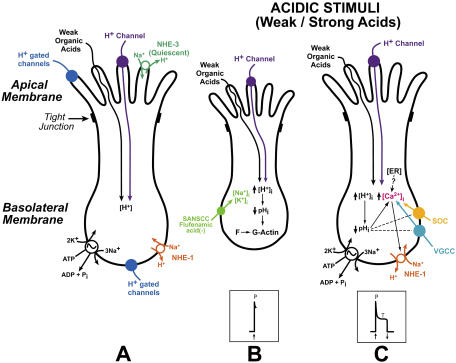Figure 15.
Proposed model for acid transport in fungiform TRCs and sour taste transduction in the anterior tongue. (A) Proposed acid transporters in TRC membranes. (B) An acid-induced decrease in TRC pHi causes cell shrinkage and the activation of a flufenamic acid–sensitive shrinkage-activated nonselective cation channel that is involved in eliciting the phasic part of the CT response to acidic stimulation (P). (C) In a subset of TRCs a decrease in pHi induces an increase in [Ca2+]i that in turn activates basolateral NHE-1. Activation of NHE-1 is responsible for pHi and cell volume recovery and for the neural adaptation (tonic response [T]) in the CT response to acid stimuli. The abbreviations used in the figure are as follows: H+-gated channels (HCN, hyperpolarization-activated channel; ASIC, acid-sensing ion channel; TASK-2, a two pore domain K+ channel); NHE-1, basolateral Na+-H+ exchanger; NHE-3, apical Na+-H+ exchanger; SANSCC, shrinkage-activated nonselective cation channel; SOC, store-operated Ca2+ channel; VGCC, voltage-gated Ca2+ channels; activation (+); Inhibition (−); increase (↑); decrease (↓). See text for details.

